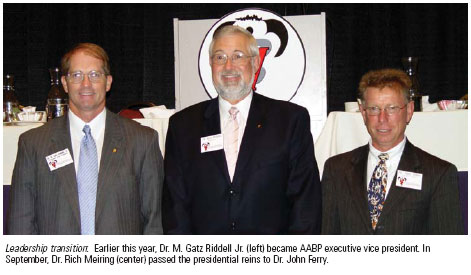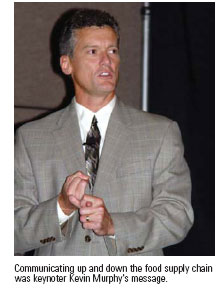Move follows AABP conference
| Three weeks after AABP members gathered in Salt Lake City for their 38th annual conference, the American Association of Bovine Practitioners moved its headquarters from Georgia to Alabama, continuing the transition to new management. The transition began in February with the appointment of Dr. M. Gatz Riddell Jr. to succeed the late Dr. James A. Jarrett as executive vice president. Rome, Ga., had been AABP headquarters since Dr. Jarrett took over the reins in 1993. The interstate move to Auburn, Ala., was made this October, and AABP headquarters officially opened there Oct. 17. Dr. Riddell is making an incremental transition to executive vice president, at present devoting about 80 percent of his time to the AABP and the remainder to his professorship in the Department of Clinical Sciences, Auburn University College of Veterinary Medicine. Heading the slate of officers who will work with Dr. Riddell over the coming year is Dr. John Ferry, Adams, N.Y., who ascended to the presidency (see profile). Dr. Ferry succeeded Dr. Rich Meiring, The Ohio State University. Dr. Charlie Hatcher, College Grove, Tenn., assumed the office of president-elect. Dr. Michael Bolton, Greenville, Mich., retired as director of District 4 to become vice president. Prior to the conference, AABP members elected Dr. Richard Wiley, West Salem, Ohio, to replace Dr. Hatcher as District 4 director; Dr. Shawn Blood, Guymon, Okla., as District 7 director; and Dr. John Lee, Merced, Calif., as District 10 director. The Salt Lake meeting, Sept. 24-26, drew more than 1,700 registrants, including 850 veterinarians and 169 students.
Murphy said, "The whole system begins with, is fueled by, and ends with the consumer. The reason that is key is because we used to produce products and inflict them on the consumer." All the people within the chain must work together to bring products back around to the consumer. "This cycle is spinning a lot faster than it ever has," he said. Murphy defined "winning brands" as carefully designed business systems and said that a system stretches from the choice of raw materials to the final product. Today it's the total production system that counts, not just the end product. "More and more, companies are looking inside the system," he said. The makers of Gerber baby foods monitor the production systems used by its ingredient suppliers. Cargill's brand advertising indicates it gets involved in the type of feed being given to cows that are the source of its products. "The missing link in the food chain is communication," Murphy said. "Full-circle communication allows you to safeguard the journey of your brand." A 2001 survey Vance conducted of 3,200 people in the pork market found that people rarely talk to others in the supply chain who aren't direct suppliers. Murphy said veterinarians need to tell their story, otherwise, someone down the chain may dictate the way they do business.  It was a veterinarian, for example, who informed the restaurant chain Chipotle of the legitimate need for hormone and antimicrobial use, leading the company to pull its ad campaign "We don't stick our animals." Surveys such as one partially underwritten by the Animal Agriculture Alliance show that consumers have deep trust and confidence in veterinarians. Murphy said that as the food system comes into clearer view, consumers will be looking for credible, trustworthy sources. He noted that ads such as PETA ran in the New York Times depicting "veterinarians without a heart" illustrate that activists will try to erode that credibility if their product (or issue) attacks don't work. Murphy suggested reading "From Mind to Market: Reinventing the Retail Supply Chain," by Roger Blackwell, and subscribing to a free tool offered by Vance—the Food Systems Insider e-version newsletter. Log on here. Studies encompass bovine practiceSummaries of two industry studies were presented at a general session on the future of bovine practice. Dr. Roger Saltman spoke on the AVMA-Pfizer Business Practices Study. This study identified management behaviors, attitudes, and actions that affect practitioner incomes. A report in the AABP proceedings by Dr. Saltman and senior author Dr. Fred D. Lehman explained the overall findings but also zeroed in on bovine-specific data. Dairy veterinarians earn on average $97,410 per year, for example, while beef veterinarians earn $83,620. Preliminary information from a study commissioned by the Food Supply Veterinary Medicine Coalition was presented by Dr. Rod Sydenham, AABP member and coalition chair, along with two of the authors, David Andrus, PhD, and Bruce Prince, PhD. The FSVMC/Bayer study addressed the demand for and availability of food supply veterinarians in the United States and Canada, and factors influencing attraction and retention. (Executive summaries of the areas of focus in the study report will be published in JAVMA.) The AABP presentation focused on job satisfaction, turnover intentions, and demand for beef cattle and dairy cattle veterinarians. After attending the session, former AABP president Dr. Lawrence Hutchinson remarked, "The study relating to food supply veterinary medicine tells us that some things aren't as bad as we thought, while there are other things we need to work on—for example, the mixed messages that some teachers give students about careers in food supply veterinary medicine." Cultivating food supply studentsFive veterinary students who have proven their interest in food supply veterinary medicine and excelled during their first three years of veterinary school were recognized by the AABP and Schering-Plough Animal Health with $1,000 stipends and plaques. Recipients of the second annual AABP/Schering-Plough Animal Health Student Recognition Award were Egan Brockhoff (SKW '06), Nathan Dorshorst (WIS '06), Rebecca Mentink (WIS '07), Joseph Shockey (OSU '06), and Matthew Walker (PEI '06). The AABP awarded the Amstutz Scholarship to 22 second-year veterinary students. Each scholarship was increased to $1,500 this year. Funding sources for this award include AABP member donations and a generous annual contribution from the Eli Lilly Foundation through Elanco Animal Health. Seven AABP members were recognized as new gold-level donors for contributing at least a thousand dollars since the scholarship program was initiated. New award recognizes young leadersDeserving AABP members who have graduated within 10 calendar years will be eligible for a new award. The James A. Jarrett Young Leader Award will recognize members who have made important contributions toward ensuring the AABP's current success and future viability. The award consists of a commemorative plaque and ring. Its namesake is the late AABP executive vice president.
| ||
 Keynoter Kevin Murphy's message in his address on "Full Chain View: Full Circle Communication" was that veterinarians must become what he calls directors of veterinary marketing, communicating with all the other members of the food supply chain. As director of market development for Vance Publishing Corp.'s newly formed Food Division, he takes his message up and down the chain, gaining insights into the impact others are having and will have on veterinarians' business.
Keynoter Kevin Murphy's message in his address on "Full Chain View: Full Circle Communication" was that veterinarians must become what he calls directors of veterinary marketing, communicating with all the other members of the food supply chain. As director of market development for Vance Publishing Corp.'s newly formed Food Division, he takes his message up and down the chain, gaining insights into the impact others are having and will have on veterinarians' business. Dues increased
Dues increased The Lameness Committee presented guidelines for severely lame cows, which the Welfare Committee found to be "an excellent document," to the board for consideration.
The Lameness Committee presented guidelines for severely lame cows, which the Welfare Committee found to be "an excellent document," to the board for consideration.